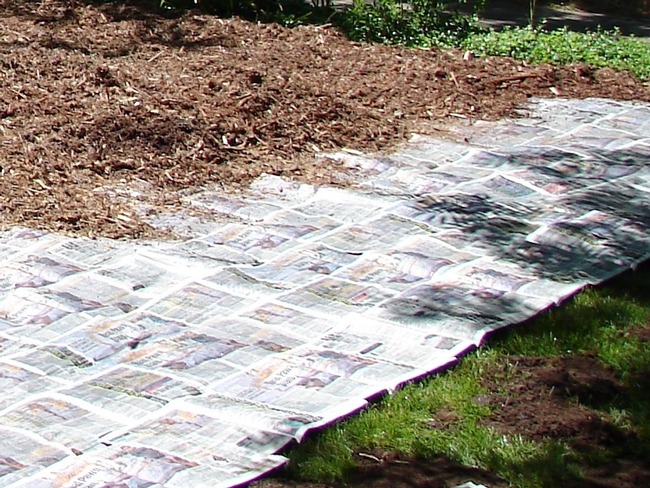By Eve Werner, Butte County Master Gardener, May 9, 2014
Are you ready to reduce water consumption by removing your lawn? Fortunately, this doesn't have to be an expensive, back-breaking, or toxic undertaking. Sheet mulching, also known as sheet composting, is a non-toxic method of lawn removal that requires inexpensive materials, simple skills, and average physical ability.

Sheet mulching is effective on all types of lawn, including Bermuda grass. It works in either sun or shade. It can be started any time of the year. It will take six to ten months to kill a lawn using this method.
Materials:
- Newspaper or plain cardboard. Don't use glossy colored pages as they may contain metal pigments.
- A hose with a spray attachment.
- A one- to two-inch layer of compost or worm castings, if your plan is to create an edible garden or a traditional landscape garden once the lawn is gone. No compost is needed for most native plant gardens. Quantity calculation: (Area in square feet) x .08 to .15 ÷ 27 = cubic yards of compost required.
- A five- to six-inch layer of wood chip mulch. ‘Walk-on' type bark, available at landscape supply yards, has longish strips of bark that help it knit together. Trees companies can supply chipped wood/bark for much less cost; verify with the supplier that it is disease free. Quantity calculation: (Area in square feet x .41 to .5) ÷ 27 = cubic yards of mulch required.
Preparation
- Scalp your lawn with the mower set at the lowest setting.
- Water the lawn thoroughly. If soil is compacted, prevent runoff: apply water for a short period, let it soak in, and then repeat as needed.
- To reduce spillage of mulch onto adjacent paving, dig a shallow beveled trench at the perimeter of the lawn area. Flip excavated lawn pieces upside down onto the remaining lawn and flatten with the back of a shovel.
Process
- Sheet mulching is most efficiently done by three people working together: one to spread the paper, one to sprinkle the water, and one to spread the compost and mulch.
- For an area where you intend to create an edible or traditional landscape garden, spread compost to a depth of one to two inches over the lawn. Omit this step for most native plant gardens.
- On a windless day, place newspaper (in thickness of five to ten sheets) or cardboard over the grass to be killed, overlapping it like shingles. Lightly sprinkle the newspaper with water as you go to prevent it from blowing away. Make sure there or no gaps or holes.
- If you are laying the sheeting around existing plants, keep the paper twelve inches away from the plant stems.
- Apply the mulch as you lay down the paper to prevent the paper from tearing or blowing away. Put a five- to six-inch thick layer of mulch over the entire area.
Leave the sheet mulching in place. Allow nature six to ten months to complete the work of killing and composting your former lawn.